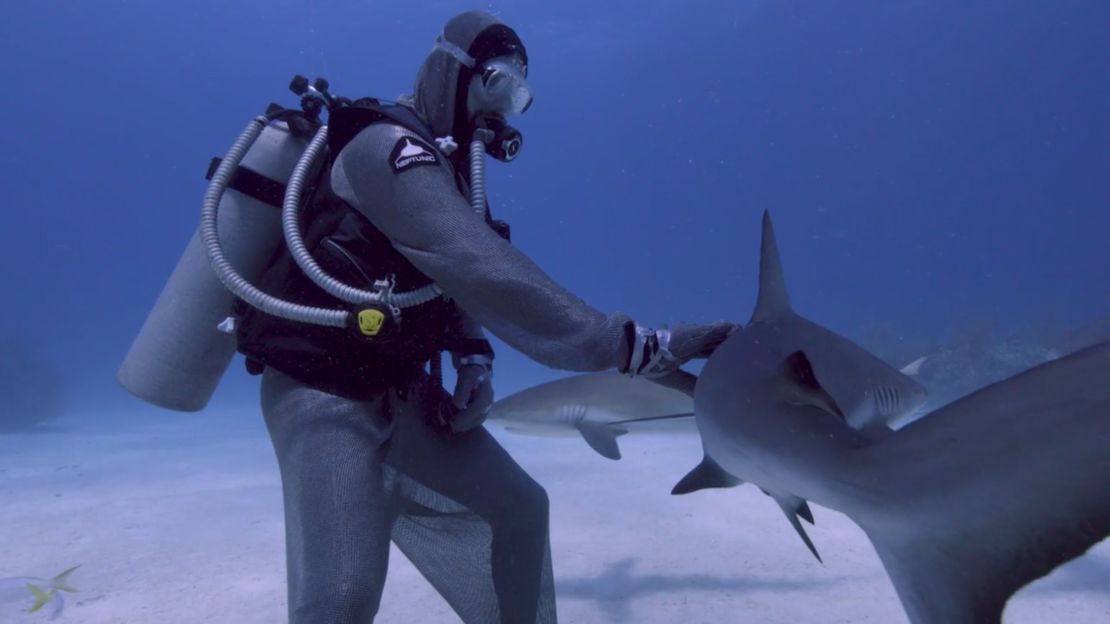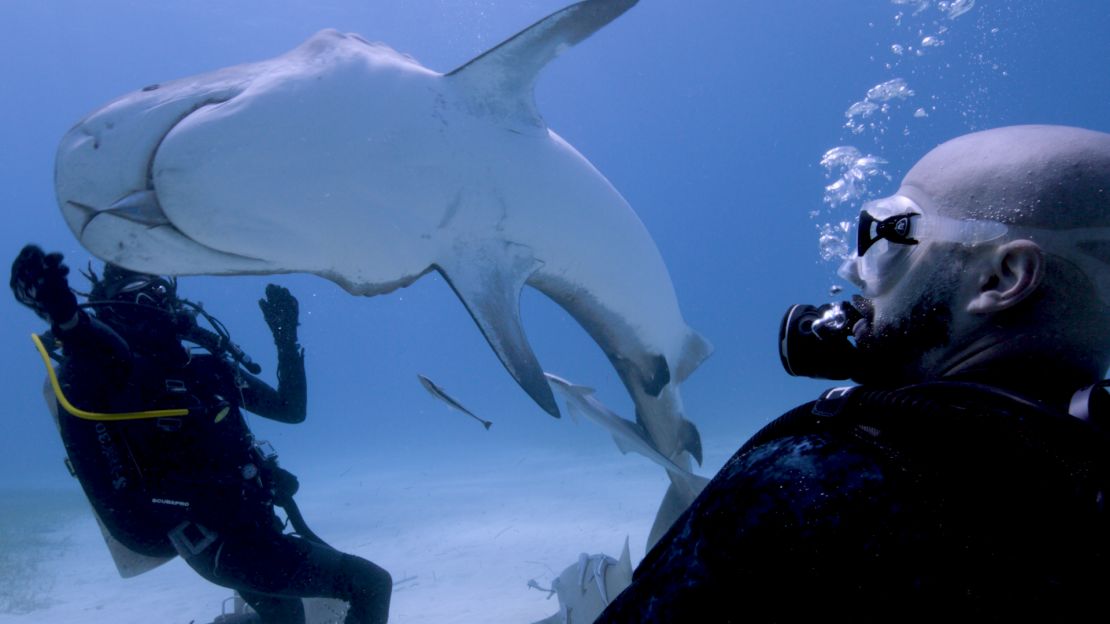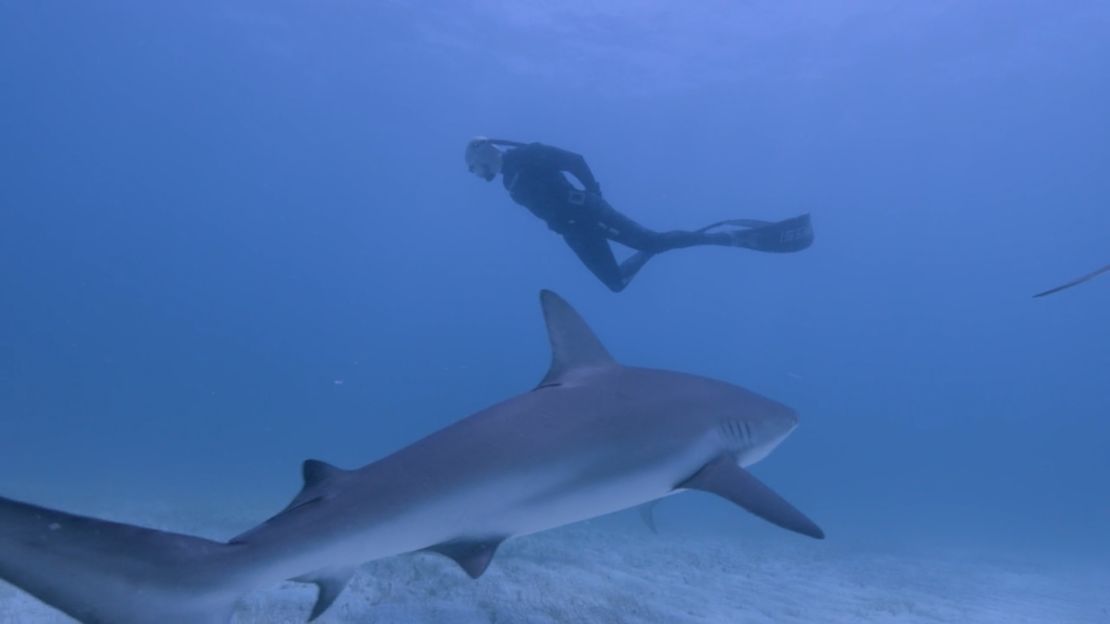Editor’s Note: Boris Sanchez is a CNN anchor based in Washington, DC, where he currently co-anchors “CNN News Central” weekdays from 1-4 PM ET. The views expressed in this commentary are his own. Read more opinion on CNN. “Deep Dive: The Shark Wars” on The Whole Story with Anderson Cooper delves into the growing conflict between an ancient predator and their modern-day competition for prey: Humans. It premieres Sunday, June 30 at 8pm ET/PT on CNN.
There are shadows lurking, circling us.

Known for remorseless eyes and staggered rows of razor-sharp teeth, these silhouettes carry a lethal reputation.
In the ring of turquoise blue, you can barely make out the grey, jagged shapes in the underwater horizon, but it’s clear they are creeping closer.
Kneeling on the sandy bottom of Tiger Beach in the Bahamas, some 30 feet below the waves, you’re instructed to limit movement and steady your breath. Don’t betray any fear or panic. I’m told that only attracts them to you.
In a flash, one darts forward — forceful and fast — zooming toward a bait box a few feet away. As her black eyes roll over white, her mouth gaping wide with ridged teeth on display, you remember just how lucky you are to not be on the menu.
Fed a half-serving of bonito fish from the hand of our divemaster, she twirls gracefully. Her eyes meet my own. Glimmering in a web of sun rays, her skin is covered in stripes and scars. With a flick of her tail, this nearly 16-foot beast pivots and heads back into the blue horizon, soon to return for more.
Tiger sharks are known for their appetites.

What’s the journalistic purpose of coming face-to-face with a massive predator as it’s being fed, especially one frequently portrayed as a ruthless monster?
Precisely to fact-check those depictions.
From my personal experience diving with sharks, I felt compelled to dispel horror movie tropes and show these creatures in a more accurate light: graceful, curious and fragile.
Juxtaposing the complexity of these sophisticated animals with the gruesome tactics historically used to harvest them (or locally diminish their numbers, via culling) was at the heart of our story.
Hampered by economic constraints on land, both commercial and recreational anglers in the US say they’re finding it harder to make ends meet. One of their biggest competitors on the open water: a shark population that’s surging, they argue, thanks to decades of federal protections.
Depicting that conflict for our viewers required more than filming aboard a boat or in an aquarium. It depended on us taking part in a practice rife with passionate disagreement in itself: shark-feeding tourism.
Expeditions are led by private companies that allow people to dive with sharks, where the animals are drawn in by chum and hand-fed in front of tourists. The exact process varies based on the operator, the species they’re trying to attract, the underwater environment and local laws.
Nevertheless, in recent decades, a number of commercial dive outfits have emerged to offer adventure tourists the chance to observe these animals first-hand. You’ll find shark feeding tours in many places where there are sharks and warm enough water.
Also seemingly ubiquitous: critics concerned about potential harm to both sharks and humans, who argue the practice should be banned.
This is the point where I should note: I’m neither a marine biologist nor a dive professional. Yet, there are arguments that the potential problems caused by shark feeding tourism are outweighed by the benefits.
For one, it’s extremely profitable and sustainable — consider the math.

If a critically endangered great hammerhead shark is caught and killed, its fins — the most lucrative part for fishermen — would sell for roughly $300 per pound on the open market.
Some estimates, however, show that if kept alive, that single shark could generate nearly $300,000 annually for the economy of the Bahamas. Add up shark and ray tourism and diving, then multiply the thousands of divers happy to pay for an up-close encounter, and it’s no surprise the Bahamas generates about $114 million dollars a year from shark and ray tourism.
That doesn’t include the any extra revenue from other activities divers and their partners decide to enjoy visiting the islands: meals, souvenirs, sunscreen.
It’s a major chunk of the economy — and part of why the commonwealth has some of the strictest protections for sharks around the globe. Fishermen are incentivized to keep shark populations healthy. Not only do the sharks and the environment thrive, but so does business.
Profits aside, some contend that shark feeding causes ecological disruption. They say sharks’ migration patterns and feeding habits can be altered by creating dive sites where they can routinely access readily available food. Worse, some experts suggest sharks have begun developing a Pavlovian response to divers and boats — associating humans with food.
When it comes to migratory patterns, the science is limited but points to shark feeding having a negligible effect on their movement. Scientists using satellite tracking data to monitor tagged sharks rejected the idea that ecotourism altered the animal’s habitat use or long-distance migration.
How about feeding habits? If predators are being fed regularly, does their fitness suffer? Does their predatory drive diminish?
While at least one study published in the Zoological Society of London’s journal Animal Conservation indicates that certain sharks’ dietary needs can be met through regular feedings, other research shows that if feeding rates remain at the same level, there’s no long-term impact on diet or feeding behavior.
As for associating humans with food, there have been online reports that some sharks near specific dive sites have become more attuned and even aggressive toward divers. Many of these anecdotes involve spear fishermen, who naturally must contend with predators as they handle and return their catch to a boat or land.
Undoubtedly, sharks are opportunistic eaters. The number of unprovoked shark attacks did tick up in 2023, but the numbers are still considered to be within a normal range and not reflective of a change in behavior. Further, in areas like the Bahamas — where feeding is well-regulated — the numbers are in the low single digits and have remained steady for a decade.
While there are multiple factors that could influence shark attack numbers year to year, including temperature and weather, the risk remains extremely low.
Generally, like most other fish, sharks are sensitive to the amount of noise divers cause. Unless they smell decaying fish, most shark species are skittish — hence why operators use bait to attract them for divers’ viewing pleasure.

Opponents of shark feeding will also point to several fatal accidents during shark dive tours, including one late last year. Accidents do happen and are devastating for those involved — though they are rare, given that this kind of shark diving has been around for more than three decades.
Responsible operators design safety guidelines and strictly enforce procedures to mitigate hazards. I’d advise anyone interested in shark diving to conduct thorough research before choosing a dive shop. Many have strong track records for safety. Even then, understand that consciously choosing to dive with sharks comes with inherent dangers.
So why take the risk?
Personally, it’s one of the most profound experiences I’ve ever had. I struggle to put it into words.
To me, locking eyes with a shark in the open ocean is an encounter with the sublime. Nothing makes me feel more calm or present. From the first time I saw a great white shark in person off the southern coast of Australia, I was hooked. It was a rush and simultaneously a deeply humbling moment.
Whether white sharks, great hammerheads, tigers or other species, all the anxieties consuming me on land melt away when I’m in water with them.
Get Our Free Weekly Newsletter
- Sign up for CNN Opinion’s newsletter
- Join us on Twitter and Facebook
I’m struck not only with an immediate awareness of mortality, but also by the overwhelming power and scale of mother nature. Of the forces that exploded together and, through millions of years of refinement, generated this delicate ecology — and its perfectly-adapted regulator: nimble behemoths that form the keystone of a healthy ocean, apex predators that flourished in our oceans before Earth even developed trees — even before the planet Saturn developed its rings!
I surface from shark dives with a renewed sense of awe and appreciation for our planet. I suspect that’s part of why it’s grown exponentially popular: There’s something powerful about facing something thought to be terrifying and recognizing it’s beauty.
Perhaps dismantling our fears and preconceived notions about “monsters” would ignite greater conservation efforts. I wish more of us would experience the power of nature first-hand, if only to better understand both our place in it and the urgent need to protect it.
As long as there are sharks in the ocean, I’ll be diving in — hoping to cherish them in person.





